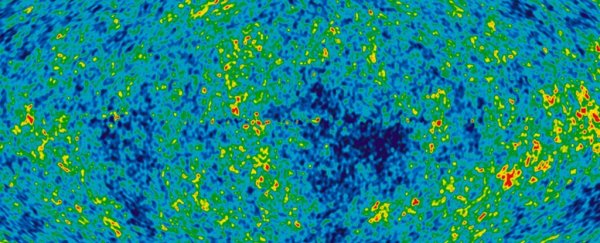Sometimes astronomers and astrophysicists are working at such gigantic, mind-bending scales – in terms of both distance and time – that you can't help but be awestruck at the new discoveries they keep coming out with.
Case in point: a temperature check of the Universe in its youngest phase, just 880 million years after the Big Bang, made possible by observing the shadow cast by a cloud of cold water gas some 13.8 billion light-years away from Earth.
It's our earliest look so far at the temperature of the Universe, which scientists think is cooling over time as it expands and spreads, and it's another really useful data point in the hunt for that most mysterious of forces behind the expansion: dark energy.
"This important milestone not only confirms the expected cooling trend for a much earlier epoch than has previously been possible to measure, but could also have direct implications for the nature of the elusive dark energy," says astronomer Axel Weiss, from the Max Planck Institute for Radio Astronomy (MPIfR) in Germany.
The key to how this was done centers on a contrast of temperatures. Using the NOEMA (Northern Extended Millimeter Array) telescope in France, astronomers focused in on the HFLS3 galaxy – known as a starburst galaxy because of the unusually high number of new stars that it's producing.
Light is taking so long to reach us from HFLS3 that we're seeing it as it was less than a billion years after the Universe came into existence. What we're also seeing is a large cloud of water vapor between us and the galaxy, a cloud that's cooler than the cosmic microwave background radiation (CMB) that indicates the Universe's temperature.
The temperature difference between the cooler gas and the CMB creates what are called absorption lines, and by studying these lines it's possible to determine the temperature of the CMB. It's a fairly complicated bit of astrophysics made possible by the infrared light emitted by the newborn stars in HFLS3.
The researchers calculate a CMB of between 16.4 and 30.2 Kelvin (-256.8 to -243 °C) at the time period represented by HFLS3, which fits with previous cosmological model predictions of 20 Kelvin. That's an important confirmation of our modeling.
"Besides proof of cooling, this discovery also shows us that the Universe in its infancy had some quite specific physical characteristics that no longer exist today," says astrophysicist Dominik Riechers, from the University of Cologne in Germany.
"Quite early, about 1.5 billion years after the Big Bang, the cosmic microwave background was already too cold for this effect to be observable. We have therefore a unique observing window that opens up to a very young Universe only."
The findings show that previous estimates of the rate of temperature decrease as it corresponds to expansion are in the right area. Trying to take this sort of reading now wouldn't work – the CMB is too cool to produce the same temperature contrast.
When it comes to dark energy, this is thought to be driving the expansion of the Universe, but being able to directly observe it remains outside the scope of our current instruments. However, we can learn more about it by observing its effects – including the rate of Universe expansion and drop in CMB temperature.
As usual, one piece of research begets many others. The research team is now looking for other cold water clouds that the same technique can be applied to, with the aim to get another reading within the first 1.5 billion years after the Big Bang.
"Our team is already following this up with NOEMA by studying the surroundings of other galaxies," says astronomer Roberto Neri, from the Institute Radio Astronomie Millimétrique (IRAM) in France.
"With the expected improvements in precision from studies of larger samples of water clouds, it remains to be seen if our current, basic understanding of the expansion of the Universe holds."
The research has been published in Nature.
